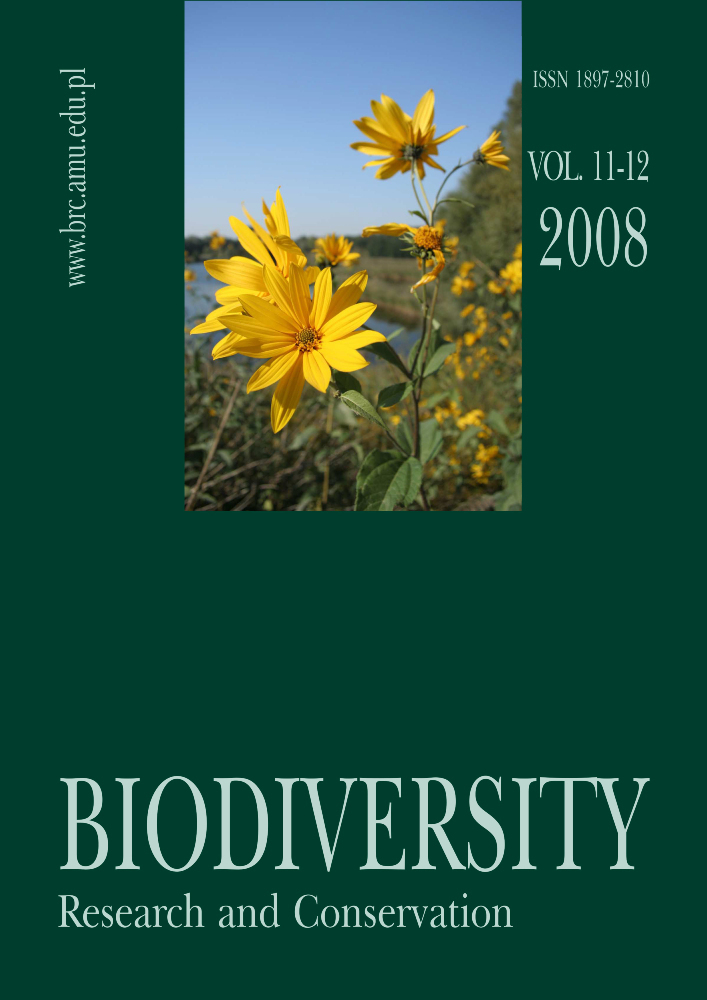Abstract
Using temperature indicator values according to Ellenberg, spatial diversity of the vascular flora was determined with regard to thermal preferences of species growing in the area of Łódź (the city with the third largest population in Poland). Study results were compared to meteorological data indicating the presence of an urban heat island (UHI). Analysis of spatial diversity of thermal preferences of the flora was conducted with regard to 292 basic study fields - squares with sides 1 km long. Indicator values of thermal preferences of the flora were determined for the flora of each basic study field - the number and percentage share of thermophilous species (T>6) as well as the average of temperature indicator values. Thermal requirements of the vascular plant species occurring in basic fields within the area of compact tenement-style buildings, industrial and railway terrain are higher than in suburban area. Average temperature indicator values for the flora of basic study fields vary from 5.28 in the peripheries to 5.97 in city centre, while the number of thermophilous species - from 1 to 34, and percentage share of thermophilous species - from 0.6% to 17.5%.
References
ELLENBERG H., WEBER H.E., DÜLL R., WIRTH V., WERNER W. & PAULISSEN D. 1991. Zeigerwerte von Pflanzen in Mitteleuropa. Scripta Geobotanica 18: 1-248.
FORTUNIAK K. 2003. Miejska wyspa ciepła. 233 pp. Wyd. Uniw. Łódzkiego, Łódź.
GÖDDE M. & WITTIG R. 1983. A preliminary attempt at a thermal division of the town of Münster (North Rhine-Westphalia, West Germany) on a floral and vegetationbasis. Urban Ecology 7: 255-262. DOI: https://doi.org/10.1016/0304-4009(83)90006-2
JACKOWIAK B. 1998. Struktura przestrzenna flory dużego miasta. Studium metodyczno-problemowe. Prace Zakładu Taksonomii Roślin UAM w Poznaniu 8: 1-227. Bogucki Wyd. Nauk., Poznań.
KŁYSIK K. 1998. Struktura przestrzenna miejskiej wyspy ciepła w Łodzi. Acta Univ. Lodz. Folia Geogr. Phys. 3: 385-391.
KŁYSIK K. & FORTUNIAK K. 1998. Dobowy i roczny cykl występowania miejskiej wyspy ciepla w Łodzi. Acta Univ. Lodz. Folia Geogr. Phys. 3: 23-32.
KŁYSIK K., WIBIG J., FORTUNIAK K., REMBOWSKI K., FOKCZYŃSKI J. & PODSTAWCZYŃSKA A. 2002. Klimat. In: S. LISZEWSKI (ed.). Atlas Miasta Łodzi. Plansza X. Urząd Miasta Łodzi. Łódzkie Tow. Nauk., Łódź.
KOWARIK I. & BÖCKNER R. 1984. Zur Verbreitung, Vergesellschaftung und Einbürgerung des Gotterbaumes (Ailanthus altissima (Mill.) Swingle) in Mitteleuropa. Tuexenia 4: 9-29.
LANDOLT E. 1991. Distribution patterns of flowering plants in the city of Zürich. In. G. ESSER & D. OVERDIECK (eds.). Modern ecology: basic and applied aspects, pp 807-822. Elsevier Publ, Amsterdam. DOI: https://doi.org/10.1016/B978-0-444-89183-9.50041-1
OKE T. R. 1995. Boundary Layer Climates. 372 pp. Methuen, London.
VON STÜLPNAGEL A., HORBERT M. & SUKOPP H. 1990. The importance of vegetation for the urban climate. In: H. SUKOPP, S. HEJNY & I. KOWARIK (eds.). Urban Ecology, pp. 175-193. The Hague SPB Academic Publishing.
SUDNIK-WÓJCIKOWSKA B. 1998a. Czasowe i przestrzenne aspekty procesu synantropizacji flory na przykładzie wybranych miast Europy Środkowej. 167 pp. Wyd. Uniw. Warszawskiego, Warszawa.
SUDNIK-WÓJCIKOWSKA B. 1998b. The effect of temperature on the spatial diversity of urban flora. In: J. B. FALIŃSKI, W. ADAMOWSKI & B. JACKOWIAK (eds.). Synantropization of plant cover in new Polish research. Phytocoenosis 10 (N.S.) Suppl. Cartogr. Geobot. 9: 97-105.
SUDNIK-WÓJCIKOWSKA B. 2000. The role of flora in bioindication of the temperature conditions in urban areas. In: B. JACKOWIAK & W. OUKOWSKI (eds.). Mechanisms of Anthropogenic Changes of the Plant Cover. Publications of the Department of Plant Taxonomy of the Adam Mickiewicz University in Poznań 10: 271-279. Bogucki Wyd. Nauk., Poznań.
SUDNIK-WóJCIKOWSKA B. 2002. Flora miasta - chaos i przypadek czy prawidłowości w różnorodnouci? Kosmos 51(2): 213-219.
SUKOPP H. & WERNER P. 1983. Urban environments and vegetation. In: W. HOLZNER, M. J. A. WERGER & I. IKUSIMA (eds.). Man’s impact on vegetation, pp. 247-260. Dr W. Junk, The Hague, Netherlands. DOI: https://doi.org/10.1007/978-94-009-7269-8_19
SUKOPP H. & WURZEL A. 2003. The effects of climate change on the vegetation of Central European cities. Urban Habitats 1(1): 66-86.
WITOSŁAWSKI P. 2006. Atlas of distribution of vascular plants in Łódź. 386 pp. Wyd. Uniw. Łódzkiego, łódź.
WITTIG R. 1991. Ökologie der Großstadtflora. 261 pp. Gustav Fischer Verlag, Stuttgart.
WITTIG R. 2002. Siedlungsvegetation. 252 pp. Verlag Eugen Ulmer, Stuttgart.
WITTIG R. & DURWEN J. K. 1981. Das ökologische Zeigerwertspektrum der spontanen Flora von Großstädten im Vergleich zum Spektrum Ihres Umlandes. Natur und Landschaft 56: 12-16.
WITTIG R. & DURWEN J. K. 1982. Ecological-value spectra of spontaneous urbanfloras. In: R. BORNKAMM, J. A. LEE, M. R. D. SEAWARD (eds.). The 2nd European Ecological Symposium: Urban Ecology, pp. 23-31. Berlin, September 1980. Blacwell Sci. Publ., Oxford.
License
Copyright © by Adam Mickiewicz University, Poznań, Poland, Department of Plant Taxonomy, 2008OPEN ACCESS




